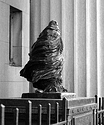Bosaiya
Member
I just picked up a Sekonic L-718 with metering attachment to measure the ground glass for macro work. Normally what I do is use my old Sekonic L-398, take an incident reading, find the equivalent reading for the bellows length, and set the lens length to that reading. This works almost flawlessly, but the meter is limited to 60seconds (most of my exposures are longer) and there is a lot of twisting of dials involved. I figured I'd get a meter with a G.G. attachment and just press a button.
The manual for the G.G. attachment says to multiply the ISO of your film by four with an example of a 100speed film being set to 400. I use 25 so I set it to 80. It says to then adjust for the darkness of the G.G. itself by measuring a lightbox with the probe and on the G.G., in their example they ended up using 500 for the film speed. So I bumped the ISO on the meter up to 100 just for a quick test. Then I blocked out the stray light as best I could (I could see the image bright and clear on the G.G.) and pushed the button with the probe firmly on the G.G. My lens was open all the way (5.6).
To say that the measurement was off would be a major understatement. On my old Sekonic a correct exposure for a 3.5" lens at 27" of bellows under the lighting conditions was 1 second. The new Sekonic measuring on the G.G. gave four minutes(!) of recommended exposure. The Polaroid test I did agreed with my old meter perfectly.
I compared the two meters just using the incident attachments and found them to be in agreement within a stop. Then I figured Id see just what ISO setting I would need to get anequivalentt reading on the new meter, figuring Id just set the new meter to that. To get the same reading I need to set it to an ISO of 4000!
Clearly I am doing something incredibly wrong - like perhaps trying to use it at all. I've read plenty of people complain that this is not a reliable method of metering, but I've also read a lot of people who wrote that it worked well. It seems unlikely that the meter would work that poorly on its own without my intervention, I can only imagine that I've messed something up along the way.
Any ideas?
The manual for the G.G. attachment says to multiply the ISO of your film by four with an example of a 100speed film being set to 400. I use 25 so I set it to 80. It says to then adjust for the darkness of the G.G. itself by measuring a lightbox with the probe and on the G.G., in their example they ended up using 500 for the film speed. So I bumped the ISO on the meter up to 100 just for a quick test. Then I blocked out the stray light as best I could (I could see the image bright and clear on the G.G.) and pushed the button with the probe firmly on the G.G. My lens was open all the way (5.6).
To say that the measurement was off would be a major understatement. On my old Sekonic a correct exposure for a 3.5" lens at 27" of bellows under the lighting conditions was 1 second. The new Sekonic measuring on the G.G. gave four minutes(!) of recommended exposure. The Polaroid test I did agreed with my old meter perfectly.
I compared the two meters just using the incident attachments and found them to be in agreement within a stop. Then I figured Id see just what ISO setting I would need to get anequivalentt reading on the new meter, figuring Id just set the new meter to that. To get the same reading I need to set it to an ISO of 4000!
Clearly I am doing something incredibly wrong - like perhaps trying to use it at all. I've read plenty of people complain that this is not a reliable method of metering, but I've also read a lot of people who wrote that it worked well. It seems unlikely that the meter would work that poorly on its own without my intervention, I can only imagine that I've messed something up along the way.
Any ideas?





